For thirty years now we've worked on documenting what Palestinian cultural heritage remains. Most of our work has been in diaspora communities, but documenting what's left in the Palestinian region is just as important. Wherever you are in the world - Gaza, Melbourne, San Francisco, Dubai, London or Ramallah - if your family is Palestinian or there are Palestinians near you, then there are stories to be told, cultural knowledge to be collected, and heritage items to be documented.
We'd love your help doing this. Why do this? Because:
- so little Palestinian heritage remains, it's important to have a document of what's left, where, and in what condition
- you'll learn so much about your family and community
- the nakba generation are not getting any younger
- it will provide a terrific resource if you ever want to curate an exhibition of your family or community's history or raise awareness of Palestinian issues
- we need a hand!
Documenting your own family's cultural items, or those of your own community, it's very easy and you can do a bit now and then, anytime. We can help with practicalities - it's basically oral history acquisition (see the National Library of Australia oral history and folklore webpage and Columbia Center for Oral History for more on this) except you have an additional component - documenting actual cultural items. Which makes it more fun.
In the old days lol, when we first started this research in the early 1980s, we'd send you all out with a big camera and a tape recorder. These days its' much easier as most mobile phones have cameras and video facilities. These aren't brilliant, but they are fine for preliminary documentation purposes and to forward on to us.
We can work on a series of questions with you, if you like, to fit your location and project. But if you're feeling confident, then read on - and then drop us a line just to let us know you're working on it.
One thing:
We can't help with funding, we are all volunteering our time and expertise here ourselves. However, keep in mind that this kind of oral history research / cultural research may be eligible for a grant at your end, depending where you are. Talk to us about it.
GETTING STARTED:
- talk to family and friends re who in your local Palestinian community might hold cultural items. If anyone in your community has ever organized an exhibition of this kind of thing, or even a political display, talk to them - they will have a good idea of where to start
- make a list of possible people to see
- talk to each person / family, asking whether they'd be willing to show your their cultural items and allow you to photograph them. Reassure them that no-one out there is trying to acquire them or take these precious items from them, that we are only recording what little Palestinian cultural heritage remains
- if the person / family agrees make an appointment to come and do the documenting. This is important because they need to put aside time to sit down and think about their history, and the story behind their cultural heritage items.
- verify each appointment the day before
- document each item by talking to their owners and photographing each item
- keep a copy of everything (it may be useful if you ever decide to do a local display, etc)
- send us a copy of everything. We'll add it into to the worldwide map we are creating. You'll be providing an important addition.
What to take:
- a digital camera or your phone or both
- a note pad + lots of pencils - don't take pens. They might leak ink on valuable textiles
- if you enjoy drawing, take a blank sketch pad.
- you might like to take a magnifying glass to look closely at some items like old embroidery
- a plain white sheet to use as a background behind the items you are photographing
- several pairs of white cotton gloves
- video camera - always worth having "just in case"
In your note pad, record for each item:
- name of item
- rough date it was acquired
- where was it acquired
- what stories are related to it
- what condition is it in (we may be able to help with conservation / storage advice + archival paper etc)
TAKING "RECORD" PHOTOS:
Don't worry about taking world class photos. The kind you are taking at this point are simply called "record shots", they preserve a record of each item. If the item is ever displayed or wanted for a book illustration or whatever then we'll talk about what's required for reproduction level images. For now, here's a few things to keep in mind.
We usually suggest wearing white cotton gloves when you take record photos, however you might want to take them off if you are trying to photograph costumes and textiles with sequins and machine stitching that might catch
DRESSES:
- try and get at least one shot of the whole garment's front and back. Here's an example of a good record quality photo of a dress sold on Ebay, that was later donated to the Archive.
- no mannequin or tailor's form? Hang a sheet over a cupboard door and photograph the garment on a hanger
- if you are photographing an embroidered dress take photos of the inside - in the vest below we've pulled back a section to show the seam hand stitching
- when taking photos of the inside of dresses keep an eye out for different fabrics used for lining and reinforcing seam edges (these fabrics help us date the garment)
- take close up photos of each area of embroidery - usually chest panel, back of neck on older dresses, cuffs, seams, skirt sections, hems.
- on older dresses the qabbeh / chest panel is often on a separate piece of fabric - run your hand gently down it's edges to see if there are any open seams - older women used this "pocket" to keep money, hankies etc. So we can tell photograph the chest panel with your hand in the open seam, like we're doing here
- if cuffs are not sitting flat, do the same thing
- with modern dresses take photos of any labels
- take photos of any embroidery designs that interest you, or seem unusual
EMBROIDERIES:
- lie flat
- photograph both sides and any labels
- take out from behind glass if framed, if possible
- if a flash is wiping out the colours, try turning the lights on in the room and turning your flash off
- if you are photographing an item embroidered with sequins like the North Sinai headveil below, you may need to turn off your flash
- for accessories like belts, etc in the photo below, you'll need to take everything out of the drawer and photograph it separately
- for kaffiyas - photograph them flat
- any refugee camp embroidery project items try and find out which project or at least which city the embroidered item came from
WORKS ON PAPER (POSTERS / POSTCARDS / PRINTED EPHEMERA):
- again take out from behind glass and turn off flash, if needed
- Don't forget to photograph the reverse - you might find something of interest on the other side, such as stamps, or in this case the very interesting text which lets us know traditional costume was still being worn in 1958
FOR VARIED CULTURAL ITEMS (KEYS / PALESTINIAN POTTERY OR GLASS / POLITICAL ITEMS / ETC)
- take a photo of the entire item and it's reverse side
- take photos of any labels
- take close up photos of interesting features
- watch the flash again on glassware
AT THE END OF EACH INTERVIEW:
- offer to help put precious items away (the owners may prefer to sit with them a while)
- be aware if you are asking about nakba stories that your interview subjects may become upset. So be prepared to stay on for a while, let them talk as long as they wish, listen to what they have to stay. These stories are your reason for being there.
- Drop us a line via our Facebook page to let us know you have reports to send in.
























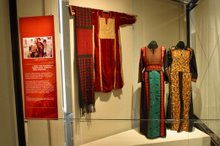






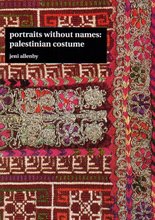
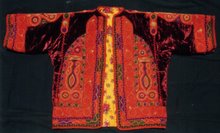
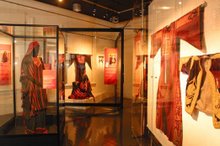
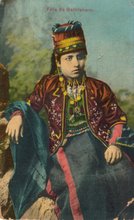

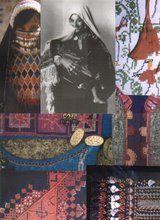













No comments:
Post a Comment